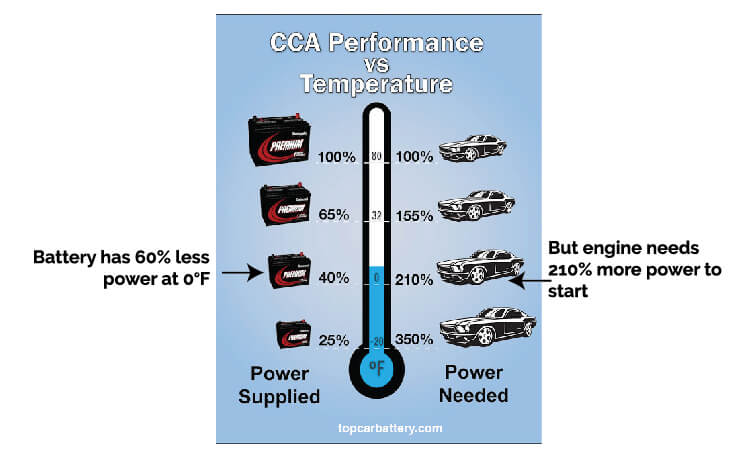How many cold cranking amps do you need
How many cold cranking amps should your battery have
The number of cold cranking amps you need is dependent on several things like the displacement size of your engine, the lowest outdoor temperature in your area, and the motor oil viscosity you use.
In other words, the larger the engine and the colder the temps, the more cold cranking amps you want in order to spin the engine fast enough to fire up.
More cylinders equals more cold cranking amps
When you crank a V-8 engine, you’re moving more metal and that takes more power than cranking a 4-cylinder engine. But the carmaker factors that into the specification for the size battery your vehicle needs. So your best bet is to consult your owner’s specifications section of the manual to find the recommended CCAs.
As a general rule, you need 1 Cold Cranking Amp for every cubic inch of engine displacement (2 CCA for diesel engines).
1L is about 61 cubic inches.
For example, a 2276 CC engine is rounded to 2.3L, which is equivalent to 140 cubic inches.
How are Cold cranking amps measured
CCA are tested with the battery chilled to 0°F (-17.8°C). Then the battery is put under load for 30-seconds and its CCA is the number of amps the battery can deliver at that temperature without dropping below 7.2-volts.
Why cold weather changes battery output
A battery creates power through a chemical reaction and that reaction slows down in cold weather. The colder it gets, the more it slows down. That means it creates less and less power as the temperature drops.
Unfortunately, your engine needs more power as temperatures drop due to turning resistance from your motor oil.  so it provides far more resistance to moving parts. Here’s a chart showing available battery power versus how much power is required to start a cold engine.
so it provides far more resistance to moving parts. Here’s a chart showing available battery power versus how much power is required to start a cold engine.
Should you buy a battery with more cold cranking amps than the carmaker recommends
Your battery tray and battery hold down brackets are made to fit a certain size battery. Lets say your car requires a Group 35 battery and the carmaker recommends a battery with 600 cold cranking amps. But you shopped around and found a Group 35 battery that has 800 cold cranking amps. Should you get it?
No. here’s why:
T o get more CCA in the same size battery, the battery manufacturer can use either thicker grids or more (thinner) grids. Each design has advantages and disadvantages. For example, if you buy a battery with a higher CCA rating that is recommended by the car maker and the battery achieves that higher CCA rating by using thinner grids with a higher paste density, that design will be far more sensitive to high temperatures, and it’s high temperatures that kill car batteries.
So in this case, you’ll be trading off winter performance for shorter battery life. Thicker grids, on the other hand, allow less room for battery electrolyte. So the battery may have high initial CCA but quickly lose its ability to output high amps because of lower levels of electrolyte.
Stick with the CCA rating of the car maker
© 2016 Rick Muscoplat
Posted on by Rick Muscoplat
